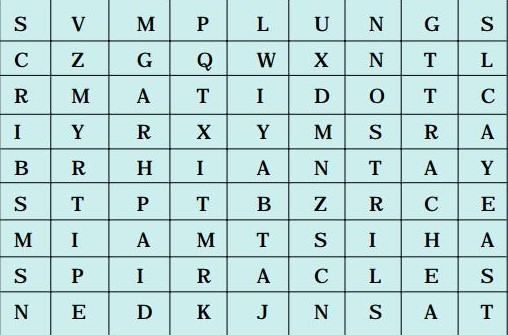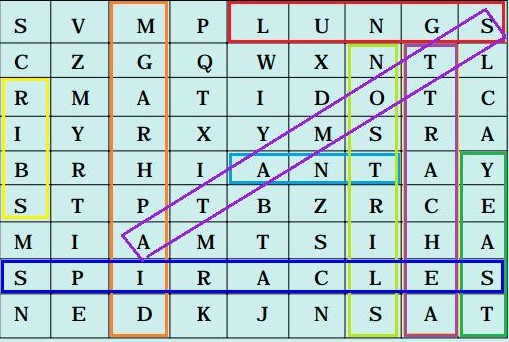Science
(www.olympiadsuccess.com)
Chapter 10: Respiration in Organisms
Class VII
NCERT Questions
Question 1
Why does an athlete breathe faster and deeper than usual after finishing the race?
Answer 1
When the athlete runs in the race, his body needs more energy. In order to get extra energy, the athlete breathes faster. Because more oxygen is supplied to our cells. It speeds up the breakdown of food and more energy is released.
Question 2
List the similarities and differences between aerobic and anaerobic respiration.
Answer 2
Similarities: Food is oxidized in both cases and energy is released.
Differences: Carbon dioxide and water are the end products of aerobic respiration, while alcohol is the end product of anaerobic respiration. Aerobic respiration releases more energy than anaerobic respiration.
Question 3
Why do we often sneeze when we inhale a lot of dust-laden air?
Answer 3
When dust particles enter our nostril, it triggers a message to the brain. The brain instructs the nasal chamber to initiate sneezing. This is a method to remove the unwanted dust particles from the nostrils. Sneezing is a type of defence mechanism used by our body.
Question 4
Take three test-tubes. Fill each of each with water. Label them A, B and C. Keep a snail in test-tube A, a water plant in test-tube B and in C, keep snail and plant both. Which testtube would have the highest concentration of CO2?
Answer 4
Living organisms release CO2 during respiration whereas plant utilize CO2 for photosynthesis. So, the test tube A will have the highest concentration of carbon dioxide because the carbon dioxide as it comes only by respiration of snail. In test tubes B and C, a part of the carbon dioxide is utilized by the plant for photosynthesis and hence there is less concentration of carbon dioxide.
Question 5
Tick the correct answer: (a) In cockroaches, air enters the body through
(i) lungs (ii) gills (iii) spiracles (iv) skin
(b) During heavy exercise, we get cramps in the legs due to the accumulation of
(i) carbon dioxide (ii) lactic acid (iii) alcohol (iv) water
(c) Normal range of breathing rate per minute in an average adult person at rest is:
(i) 9 – 12 (ii) 15–18 (iii) 21–24 (iv) 30–33
(d) During exhalation, the ribs
(i) move outwards (ii) move downwards (iii) move upwards (iv) do not move at all
Answer 5
(a) In cockroaches, air enters the body through (iii) spiracles.
(b) During heavy exercise, we get cramps in the legs due to the accumulation of (ii) lactic acid.
(c) Normal range of breathing rate per minute in an average adult person at rest is (ii) 15–18. (d) During exhalation, the ribs (ii) move downwards.
Question 6
Match the items in Column I with those in Column II:
Column I Column II
(a) Yeast (i) Earthworm
(b) Diaphragm (ii) Gills
(c) Skin (iii) Alcohol
(d) Leaves (iv) Chest cavity
(e) Fish (v) Stomata
(f) Frog (vi) Lungs and skin
(vii) Tracheae
Answer 6
Column I Column II
(a) Yeast (iii) Alcohol
(b) Diaphragm (iv) Chest cavity
(c) Skin (i) Earthworm
(d) Leaves (v) Stomata
(e) Fish (ii) Gills
(f) Frog (vi) Lungs and skin
Question 7
Mark ‘T’ if the statement is true and ‘F’ if it is false:
(iii) Frogs breathe through their skins as well as their lungs. (T/F)
(iv) The fishes have lungs for respiration. (T/F)
(v) The size of the chest cavity increases during inhalation. (T/F)
Answer 7
(i) During heavy exercise the breathing rate of a person slows down. (False) (ii) Plants carry out photosynthesis only during the day and respiration only at night. (False) (iii) Frogs breathe through their skins as well as their lungs. (True) (iv) The fishes have lungs for respiration. (False) (v) The size of the chest cavity increases during inhalation. (True)
Question 8
Given below is a square of letters in which are hidden different words related to respiration in organisms. These words may be present in any direction – upwards, downwards, or along the diagonals. Find the words for your respiratory system. Clues about those words are given below the square.

Answer 8

Question 9
The mountaineers carry oxygen with them because: (a) At an altitude of more than 5 km there is no air. (b) The amount of air available to a person is less than that available on the ground. (c) The temperature of air is higher than that on the ground. (d) The pressure of air is higher than that on the ground.
Answer 9
(b) The amount of air available to a person is less than that available on the ground.
Yearlong program for Olympiads preparation & to build necessary skills for future.
Explore More
Time to mark your calendar with the upcoming Olympiads exam schedule.
Explore More
Take your Olympiad preparation to next-level by taking LIVE Classes.
Explore More
Assess your performance by taking topic-wise and full length mock tests.
Explore More
Online tuitions for international compeitions like SASMO, SEAMO, etc for Grades 1-11.
Explore More